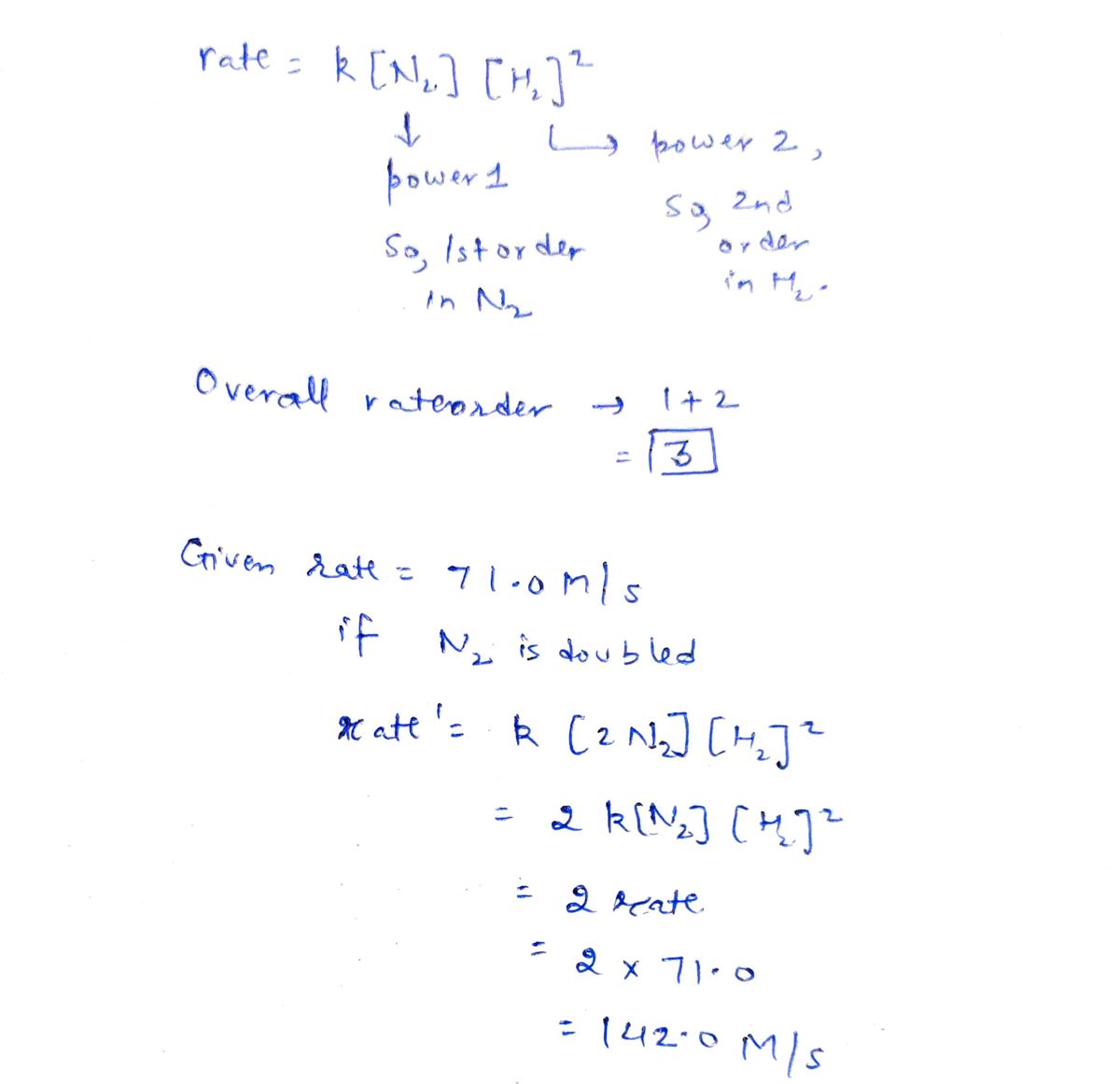The rate of a certain reaction is given by the following rate law: rate -A[N;][H+]* Use this information to answer the questions below. What is the reaction order in N,? What is the reaction order in H,? What is overal reaction order? At a certain concentration of Ny and H, the initial rate of reaction is 71.0 M/s. What would the initial rate of the reaction be if the concentration of Ny were doubled? Round M 17.8 your answer to 3 significant digits. The rate of the reaction is measured to be 0.290 M/swhen (N)- 1.6 M and [Ha)-0.71 M. Calculate the value of the rate constant. Round your answer to 2 significant digits.
The rate of a certain reaction is given by the following rate law: rate -A[N;][H+]* Use this information to answer the questions below. What is the reaction order in N,? What is the reaction order in H,? What is overal reaction order? At a certain concentration of Ny and H, the initial rate of reaction is 71.0 M/s. What would the initial rate of the reaction be if the concentration of Ny were doubled? Round M 17.8 your answer to 3 significant digits. The rate of the reaction is measured to be 0.290 M/swhen (N)- 1.6 M and [Ha)-0.71 M. Calculate the value of the rate constant. Round your answer to 2 significant digits.
Chemistry: The Molecular Science
5th Edition
ISBN:9781285199047
Author:John W. Moore, Conrad L. Stanitski
Publisher:John W. Moore, Conrad L. Stanitski
Chapter11: Chemical Kinetics: Rates Of Reactions
Section11.7: Reaction Mechanisms
Problem 11.12E
Related questions
Question
![The rate of a certain reaction is given by the following rate law:
rate -k [N;][H,]*
Use this information to answer the questions below.
What is the reaction order in Ny?
?
What is the reaction order in Hy?
2
What is overall reaction order?
At a certain concentration of N, and Hy, the initial rate of
reaction is 71.0 M/s. What would the initial rate of the
reaction be if the concentration of Ny were doubled? Round
your answer to 3 significant digits.
M
17.8
The rate of the reaction is measured to be 0.290 M/s when
(N)- 1.6 M and [H) - 0.71 M. Calculate the value of the
rate constant. Round your answer to 2 significant digits.](/v2/_next/image?url=https%3A%2F%2Fcontent.bartleby.com%2Fqna-images%2Fquestion%2F6ff5afa3-7a88-496b-9360-76d2f49b6ba3%2Fb6a598a8-3471-4410-a066-ec205057049d%2Fbpuzzr_processed.png&w=3840&q=75)
Transcribed Image Text:The rate of a certain reaction is given by the following rate law:
rate -k [N;][H,]*
Use this information to answer the questions below.
What is the reaction order in Ny?
?
What is the reaction order in Hy?
2
What is overall reaction order?
At a certain concentration of N, and Hy, the initial rate of
reaction is 71.0 M/s. What would the initial rate of the
reaction be if the concentration of Ny were doubled? Round
your answer to 3 significant digits.
M
17.8
The rate of the reaction is measured to be 0.290 M/s when
(N)- 1.6 M and [H) - 0.71 M. Calculate the value of the
rate constant. Round your answer to 2 significant digits.
Expert Solution
Step 1

Step by step
Solved in 2 steps with 2 images

Knowledge Booster
Learn more about
Need a deep-dive on the concept behind this application? Look no further. Learn more about this topic, chemistry and related others by exploring similar questions and additional content below.Recommended textbooks for you

Chemistry: The Molecular Science
Chemistry
ISBN:
9781285199047
Author:
John W. Moore, Conrad L. Stanitski
Publisher:
Cengage Learning

Chemistry: An Atoms First Approach
Chemistry
ISBN:
9781305079243
Author:
Steven S. Zumdahl, Susan A. Zumdahl
Publisher:
Cengage Learning

Chemistry
Chemistry
ISBN:
9781305957404
Author:
Steven S. Zumdahl, Susan A. Zumdahl, Donald J. DeCoste
Publisher:
Cengage Learning

Chemistry: The Molecular Science
Chemistry
ISBN:
9781285199047
Author:
John W. Moore, Conrad L. Stanitski
Publisher:
Cengage Learning

Chemistry: An Atoms First Approach
Chemistry
ISBN:
9781305079243
Author:
Steven S. Zumdahl, Susan A. Zumdahl
Publisher:
Cengage Learning

Chemistry
Chemistry
ISBN:
9781305957404
Author:
Steven S. Zumdahl, Susan A. Zumdahl, Donald J. DeCoste
Publisher:
Cengage Learning


Chemistry: Principles and Practice
Chemistry
ISBN:
9780534420123
Author:
Daniel L. Reger, Scott R. Goode, David W. Ball, Edward Mercer
Publisher:
Cengage Learning

Chemistry by OpenStax (2015-05-04)
Chemistry
ISBN:
9781938168390
Author:
Klaus Theopold, Richard H Langley, Paul Flowers, William R. Robinson, Mark Blaser
Publisher:
OpenStax